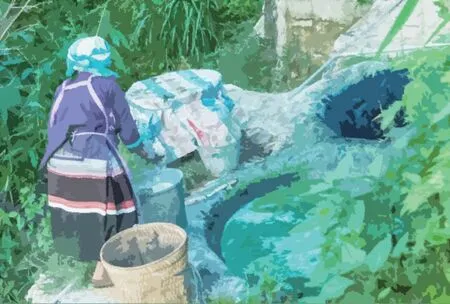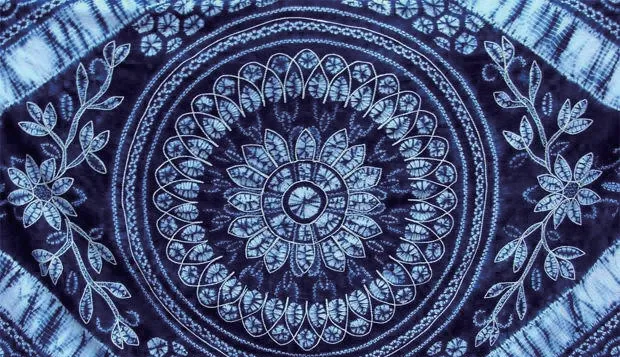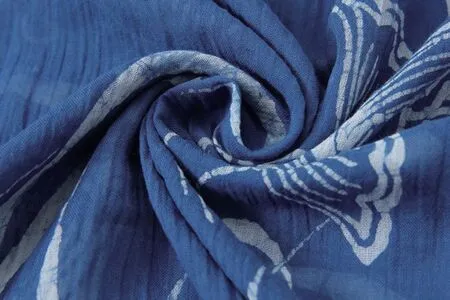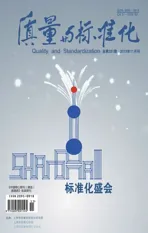青出于蓝的印染美学
2019-04-02五花肉
文/五花肉

上一期,专栏聚焦计量器具的发展,介绍了“利在千秋的法定基准”。本期,我们关注服饰的染色工艺,欣赏“青出于蓝的印染美学”。
In the last issue, the column focused on the development of measuring instruments and introduced "Legal Benchmark for Benefit in the Future". In this issue, we shall pay attention to clothing dyeing process and appreciate "Dyeing Aesthetics of Excellence".
爱美之心,人皆有之。早在新石器时代,古人就学会了以自然界中五颜六色的矿物质为原料,提取色彩来妆点服饰,进而发明了石染、草染、扎染等不同时期的染色工艺。
Everyone has a love of beauty. As early as the Neolithic Age, ancient Chinese learned to use the colorful minerals in nature as raw materials to extract colors and to make up costumes, and then invented dyeing techniques in different periods such as stone dyeing, grass dyeing and tie dyeing.

石染:原始朴素
Stone Dyeing: Primitive Simplicity
作为最原始的染色工艺,石染法的关键是找到所需颜色的矿石,将其研磨成粉后,直接涂抹在服饰之上,或经胶状材料调和后附着于服饰表面。
As the most primitive dyeing process, the key of stone dyeing process was the ores with the required color. Ancient Chinese ground ores into powder, applied them directly on the clothing, or adhere dyeing glue to the clothing surface after blending with colloidal materials.
受限于当时的技术和工具,石染法使用的矿物颜料颗粒度较大,化学性质稳定,纤维亲和力不足,只能以物理附着的方式进行染色,每次染色只能选择单一颜色,色泽与图案也十分朴素。
Limited by the technology and tools at that time, mineral pigments used in stone dyeing process were of large granularity, stable chemical properties and insuffcient fiber affnity. As a result, they could only be dyed by physical attachment. Only a single color could be selected for each dyeing, and the color and pattern were also very simple.
草染:质的飞跃Grass Dyeing: Substantial Development
进入农业社会后,人们逐渐发现,与矿物质相比,植物中的色素分子有着更佳的纤维亲和力,进而探索出更为复杂的草染法,实现了从矿物涂染到植物浸染的飞跃。
After entering the agricultural society, ancient Chinese gradually found that pigment molecules in plants were of better fiber affinity than minerals, and further developed more complex grass dyeing techniques, which realized a leap from mineral coating to plant impregnation.
据《考工记·钟氏染羽》记载,先秦时期的工匠利用加热提纯、氧化反应等操作,通过多次浸染,可以印染出赤黄、深青、黑色等多种色彩。自此,这一工艺成为了我国古代印染行业的主流标准,并日趋规范,让印染之美从王公贵族走向千家万户。
According to "Kao Gong Ji Zhong Shi Ran Yu"( technological document for dyeing process in Kao Gong Ji), craftsmen in the pre-Qin period used heating purification, oxidation reaction and other operations to dye many colors such as red yellow, dark green and black through multiple impregnation. Since then, this process has become the mainstream standard in Chinese ancient dyeing industry. With the development of standards,beauty of dyeing became popular among ordinary people from the nobility.
扎染:成就卓越
Tie-dyeing: Outstanding Achievements
随着经济社会的发展,人们对色彩的审美要求也水涨船高,更加繁复艳丽的扎染法便应运而生。
With the development of economy and society and rise of people's aesthetic taste, more complicated and colorful tie-dyeing methods emerged.
这种工艺将待染品用绳线捆扎后染色,常见的扎法包括针缝、打结和器具辅助等,捆扎力度、绳线粗细长短、折叠次数和方向等皆有明确标准,以此实现部分染色的目的,进而产生精准的特殊花纹和复杂多变的色彩效果,成就了我国古代印染技术的卓越丰碑。
In this process, the products to be dyed were tied with cord and dyed. Common tying methods included needle sewing, knotting and appliance assistance. There was a system of standards for tying strength including length and thickness of cord, folding times and direction. With the development of standards, ancient Chinese mastered partial dyeing techniques to produce precise special patterns and complicated and changeable color eあects, which achieved dyeing technology outstanding monument in Chinese history.
结 语
Conclusion
从涂染、浸染到扎染,印染工艺在发展中不断成长,在规范中走向卓越,“青出于蓝,更胜于蓝”,让服饰焕发生命的同时,也妆点出更加绚烂的生活。
From painting and dyeing to tie-dyeing, dyeing technology kept improving and achieving excellence. "Dyeing Aesthetics of Excellence" makes clothing glow with life and highlights more splendid life.

